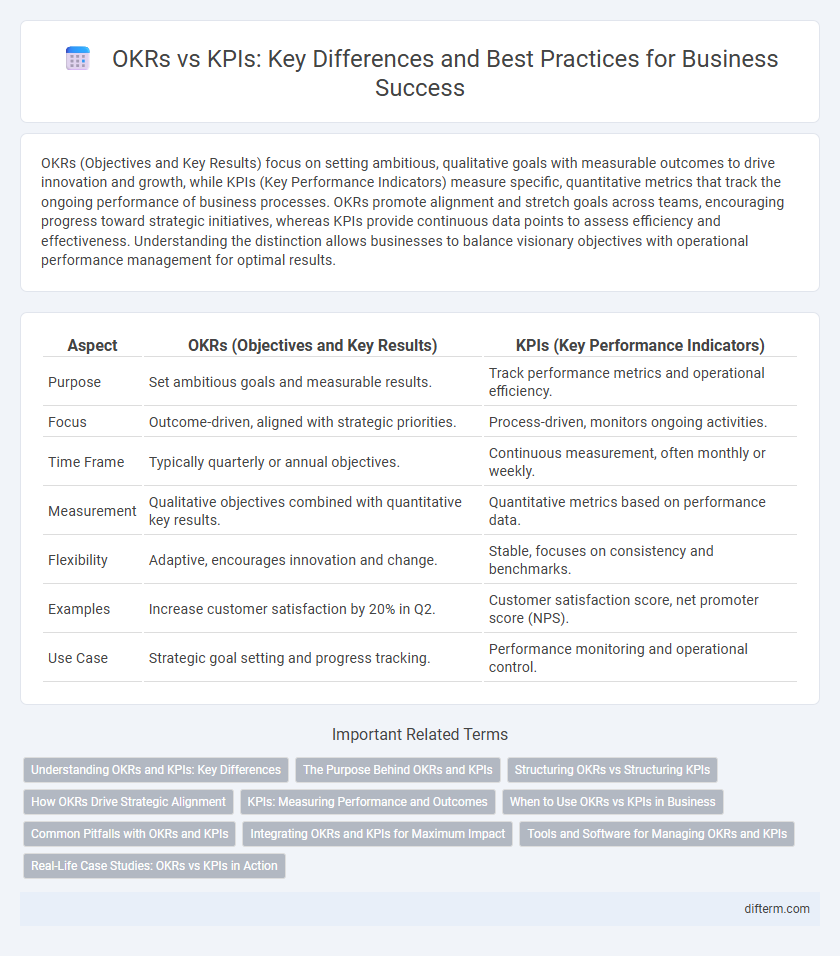OKRs (Objectives and Key Results) focus on setting ambitious, qualitative goals with measurable outcomes to drive innovation and growth, while KPIs (Key Performance Indicators) measure specific, quantitative metrics that track the ongoing performance of business processes. OKRs promote alignment and stretch goals across teams, encouraging progress toward strategic initiatives, whereas KPIs provide continuous data points to assess efficiency and effectiveness. Understanding the distinction allows businesses to balance visionary objectives with operational performance management for optimal results.
Table of Comparison
| Aspect | OKRs (Objectives and Key Results) | KPIs (Key Performance Indicators) |
|---|---|---|
| Purpose | Set ambitious goals and measurable results. | Track performance metrics and operational efficiency. |
| Focus | Outcome-driven, aligned with strategic priorities. | Process-driven, monitors ongoing activities. |
| Time Frame | Typically quarterly or annual objectives. | Continuous measurement, often monthly or weekly. |
| Measurement | Qualitative objectives combined with quantitative key results. | Quantitative metrics based on performance data. |
| Flexibility | Adaptive, encourages innovation and change. | Stable, focuses on consistency and benchmarks. |
| Examples | Increase customer satisfaction by 20% in Q2. | Customer satisfaction score, net promoter score (NPS). |
| Use Case | Strategic goal setting and progress tracking. | Performance monitoring and operational control. |
Understanding OKRs and KPIs: Key Differences
OKRs (Objectives and Key Results) emphasize ambitious, qualitative goals linked to measurable outcomes, driving alignment and focus within organizations. KPIs (Key Performance Indicators) measure specific operational metrics, providing quantifiable performance data to track progress against established targets. Understanding the key difference where OKRs inspire change and innovation, KPIs monitor efficiency and results, enables better strategic planning and performance management.
The Purpose Behind OKRs and KPIs
OKRs (Objectives and Key Results) are designed to drive ambitious goal-setting and foster alignment across teams by focusing on measurable outcomes that push innovation and growth. KPIs (Key Performance Indicators) serve to monitor ongoing performance and operational efficiency through specific, quantifiable metrics tied to business processes. The purpose behind OKRs centers on strategic transformation and motivational progress, while KPIs emphasize tracking and maintaining steady performance standards.
Structuring OKRs vs Structuring KPIs
Structuring OKRs involves setting ambitious, qualitative objectives paired with measurable key results that track progress and inspire innovation, emphasizing alignment and transparency across teams. In contrast, KPIs are structured as specific, quantifiable metrics focused on monitoring performance and operational efficiency, often tied to predefined targets and benchmarks. Effective business management integrates OKRs to drive strategic objectives while using KPIs to maintain ongoing performance control.
How OKRs Drive Strategic Alignment
OKRs drive strategic alignment by linking individual and team objectives to the company's overarching goals, creating clear focus and measurable outcomes. Unlike KPIs, which track performance metrics, OKRs encourage ambitious goal-setting and continuous progress evaluation. This alignment fosters collaboration, transparency, and agility across all organizational levels.
KPIs: Measuring Performance and Outcomes
KPIs (Key Performance Indicators) are quantifiable metrics essential for measuring a company's performance and outcomes against strategic goals. They provide specific data points such as sales revenue, customer retention rate, and operational efficiency, enabling businesses to track progress and make informed decisions. Unlike OKRs, which focus on ambitious objectives and measurable results, KPIs emphasize ongoing performance measurement to ensure accountability and continuous improvement.
When to Use OKRs vs KPIs in Business
OKRs (Objectives and Key Results) are ideal for driving ambitious growth and strategic alignment across teams by setting measurable goals with inspirational outcomes, while KPIs (Key Performance Indicators) track ongoing operational performance and efficiency through specific metrics. Use OKRs during periods of change or innovation when focus and engagement on transformative goals are needed, and employ KPIs continuously to monitor critical business processes and outcomes against established benchmarks. Combining both frameworks allows businesses to balance visionary objectives with day-to-day performance measurement for sustained success.
Common Pitfalls with OKRs and KPIs
Common pitfalls with OKRs and KPIs include setting overly ambitious or vague objectives, leading to unclear measurement and lack of focus. Confusing outputs with outcomes often results in tracking irrelevant metrics that do not drive strategic goals. Failing to align OKRs and KPIs with overall business objectives causes miscommunication and hampers performance management.
Integrating OKRs and KPIs for Maximum Impact
Integrating OKRs (Objectives and Key Results) with KPIs (Key Performance Indicators) creates a comprehensive performance management system that drives both strategic alignment and operational efficiency. OKRs set ambitious goals and measurable outcomes, while KPIs track ongoing performance metrics essential for monitoring progress and making data-driven decisions. Combining these frameworks enables businesses to maintain focus on impactful objectives while continuously optimizing key business processes for maximum impact.
Tools and Software for Managing OKRs and KPIs
Effective tools for managing OKRs and KPIs include platforms like Workboard, Gtmhub, and Weekdone, which offer real-time tracking, automated updates, and customizable dashboards. These software solutions integrate with existing business systems such as CRM, ERP, and project management tools, enabling seamless data synchronization and comprehensive performance insights. Utilizing specialized OKR and KPI tools improves alignment across teams, enhances transparency, and drives data-driven decision-making within organizations.
Real-Life Case Studies: OKRs vs KPIs in Action
Real-life case studies reveal how companies leverage OKRs (Objectives and Key Results) to drive ambitious, measurable growth, contrasting with KPIs (Key Performance Indicators) that track ongoing operational performance. For instance, Google's use of OKRs fosters innovative goal-setting and alignment across teams, whereas Walmart relies on KPIs to optimize its supply chain efficiency. These examples highlight OKRs' strategic impact on transformational objectives, while KPIs ensure consistent execution and performance monitoring.
OKRs vs KPIs Infographic

 difterm.com
difterm.com